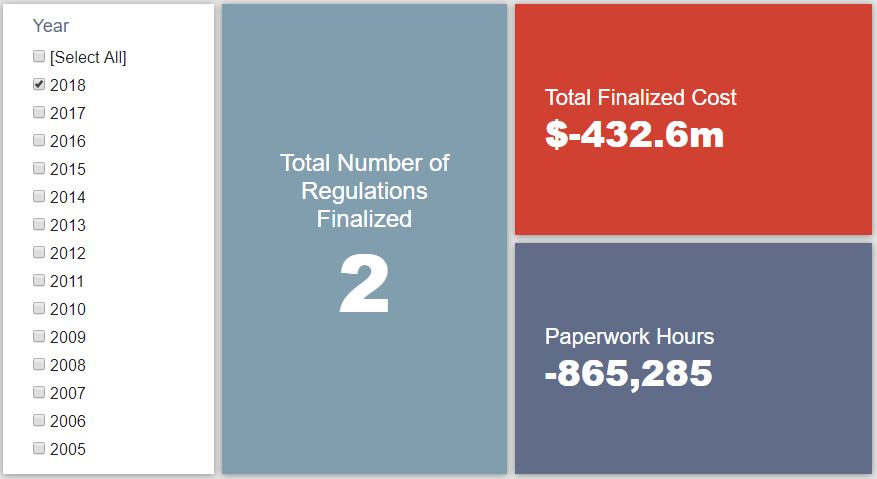Week in Regulation
January 8, 2018
A Deregulatory Start to 2018
In 2018’s frigid first week, the deregulatory trend from last year not only continued but heated up. Of the 56 rulemakings published in the Federal Register, only two had quantifiable economic estimates worth recording. One was a minor, routine airplane safety rule. The other was an Environmental Protection Agency (EPA) measure that could provide affected entities with nearly $435 million in lifetime cost savings. The per capita regulatory burden for 2018 is negative $1.34.
Regulatory Toplines
- New Proposed Rules: 16
- New Final Rules: 40
- 2018 Total Pages of Regulation: 703
- 2018 Final Rules: -$432.6 Million
- 2018 Proposed Rules: $0
Tracking Regulatory Modernization
The EPA measure largely affects the “Hazardous Waste Manifest System.” While it also adjusts some administrative items such as relevant fees, the primary economic impact comes from EPA allowing certain respondents to move towards an electronic reporting system (as opposed to the more cumbersome paper-based system). This could yield more than $434 million in savings to states and private entities over a six-year period, or essentially $66 million on an annual basis.
That $66 million in annual savings now becomes part of EPA’s “tally” under the regulatory budget established by Executive Order (EO) 13,771 for Fiscal Year (FY) 2018. According to American Action Forum (AAF) analysis, since the start of FY 2018 (beginning Oct. 1, 2017), executive agencies have promulgated 14 rules with quantified cost savings against 4 such regulatory measures under the scope of the EO per the administration’s guidance document on the matter. These rules combine for a net annual savings of roughly $447 million. The administration’s goal for FY 2018 is $687 million in net annual savings.
Click here to view AAF’s examination of the administration’s progress under the “one-in, two-out” executive order through the end of Fiscal Year 2017.
Major Obama-Era Initiatives
The Affordable Care Act and Dodd-Frank were the two legislative lodestars of the Obama administration. With President Trump’s election, any further implementation of those laws has all but dried up over the course of the past year. As the country enters the first full calendar year of the Trump Administration, agencies have now moved toward implementing very different administrative reforms in those issue areas. For instance, this past week the Department of Labor published a proposal that would effectively allow small employers to band together for health insurance under “association health plans.” Although the proposed rule does not include any quantified economic estimates, the agency argues that this move could help such employers by increasing the value of their health plan options.
Since passage, based on total lifetime costs of the regulations, the Affordable Care Act has imposed costs of $53 billion in final state and private-sector burdens and 176.9 million annual paperwork hours.
Click here to view the total estimated costs from Dodd-Frank; since passage, the legislation has produced more than 82.9 million final paperwork burden hours and imposed $38.9 billion in direct compliance costs.
Total Burdens
Since January 1, the federal government has published $432.6 million in net costs savings (all from final rules) and has cut 865,285 paperwork burden hours. Click below for the latest Reg Rodeo findings.











